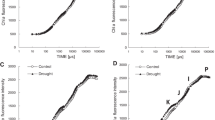Abstract.
The expression of early light-inducible proteins (ELIPs) was analyzed in non-hardened barley (Hordeum vulgare L. cv. Apex) plants which were acclimated to cold (5 °C) and high-light stress (1500 μmol · m−2 · s−1) for several days. Severe photoinhibition occurred after some hours in the cold and remained constant during the following days. Lipid peroxidation was observed only under high light in the cold; it started during the second day and increased with time of acclimation. High light induced a five- to eightfold increase in ELIP mRNA levels; a cold treatment additionally enhanced the levels up to threefold. Under photoinhibitory conditions a loss of circadian oscillation in the ELIP mRNA levels was observed. After one week in high light at 5 °C, ELIP levels were at least 40 times higher than at 25 °C. At 5 °C and a low quantum flux (100 μmol · m−2 · s−1) that did not induce ELIP at 25 °C the protein accumulated to a level that was only five times lower than under high light. Immediately after transfer to the cold, ELIP synthesis was low but the amounts of ELIP observed after 12 h were considerably enhanced and differed only slightly in low- and high-light-treated plants. These data indicate a rapid recovery of ELIP synthesis between the 4th and the 12th hour after transfer to the cold. This resumption of protein synthesis occurred after the decline of photosystem II fluorescence and before the formation of lipid hydroperoxides. Later during acclimation to cold, during which lipid peroxidation increases, only the high-light-grown plants increased their ELIP amounts noticeably. The distribution of ELIPs along the leaves of plants that were acclimated to light- and/or cold-stress conditions showed that the ELIPs are mainly located in the photosynthetic tissues while under moderate growth conditions they are mainly found in the region of dividing cells. Under high light and cold, the 40-fold increase in ELIP amounts was accompanied by a 2-fold decrease in the light-harvesting chlorophyll a/b-binding proteins of photosystem II (LHC II), which indicates a reciprocal posttranscriptional control of ELIP and LHC II genes. The possible trigger of induction of ELIPs under light and cold stresses, their function and their organisation within the thylakoids are discussed.
Similar content being viewed by others

Author information
Authors and Affiliations
Additional information
Received: 26 August 1996 / Accepted: 13 January 1997
Rights and permissions
About this article
Cite this article
Montané, MH., Dreyer, S., Triantaphylides, C. et al. Early light-inducible proteins during long-term acclimation of barley to photooxidative stress caused by light and cold: high level of accumulation by posttranscriptional regulation. Planta 202, 293–302 (1997). https://doi.org/10.1007/s004250050131
Issue Date:
DOI: https://doi.org/10.1007/s004250050131



